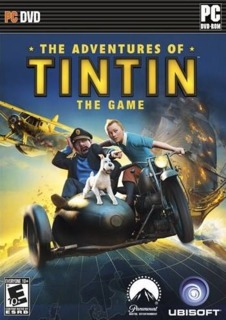After Prisoners of the Sun--finally one of Tintin's facetious adventures made available for handheld console gaming anew
Still, this platforming adventure game by Ubisoft Barcelona which loosely relates to the movie's plot has its charms for all true fans of the smart Belgian reporter. Minor inconsistencies with the cinematic narrative--neither Barnaby nor Sakharine figure here--probably are due to its being based on three different of Hergé's albums: The Secret of the Unicorn--which lent it the name--, Red Rackham's Treasure, and The Crab with the Golden Claws, all published during WWII in a Belgium under Nazi occupation.
But of course the reduced handheld version caters also to the 3DS's specific gameplay needs in order to make it an entertaining experience featuring tricky seaplane flights, miniature size naval battles, stylus-swaying sword combats, plus numerous rather amusing fight scenes, not too difficult mechanic puzzles, and above all a lot of mounting, leaping, diving, and drilling, along moving platforms, same-looking rooms, water-filled caves, and endless tunnels, where the player may occasionally also adopt the role of Snowy--or Milou--, Tintin's clever white dog.
Plenty of doors and trap-doors, bookshelves and ladders, as well as the cuckoo clock k.o. sound and an intentionally bad enemy AI give most fight scenes a slapstick-like element, where the boyish but strong Tintin throws bottles and bananas to make enemies fall, if not stealth-knocking them out like gummy dolls (A) or fist-punching them straight away (Y), which at times may become almost impossible when a foe is hiding behind a big umbrella or wearing a special suit or armor. In this case our unarmed though not harmless hero does also recur to single explosives or suspended sacks purposefully put in place to be released in a well-timed manner onto the respective foe, all of which being relatively easy to manage given the frequent checkpoints--except the repeated boss fights against Captain Haddock's treacherous first mate Allan that as a combination of jumping, climbing, dooring, aiming, and letting explode might require various trials until getting along.
As Tintin himself is imaginative and intelligent, the game wants us to likewise use our deduction skills in order to proceed, though the different tasks as such usually are simple: find an entrance, explore, find your way out, get rid of all enemies, defeat Allan or Rackham, escape..., and in general the game's platforming action might remotely recall Uncharted rather than Professor Layton.
Yet the combination of approved as well as new platforming ingredients keeps one well occupied through the six levels and 29 connected chapters, leading from Brussels's Flea Market where Tintin & Snowy discover the model ship, over the Manor of Marlinspike and Haddock's mutinied ship Karaboudjan, to Sheik Omar Ben Salaad's Palace in Bagghar and the lost Brittany island back again to Marlinspike and the final revelation. On this journey we learn but also the true story of our Captain's ill-fated ancestor, sir Francis Haddock, whose supposed cowardice--abandoning his crew and blowing up the Unicorn, valiant ship of King Charles II's fleet, when attacked by the pirate Red Rackham in 1676--did curse all his descendants including the last, Tintin's unsober friend Archibald Haddock ("Pickled herrings! Iconoclasts! Anachronisms!").
After completing the game the story can be "relived" thanks to the Passport's thirty-six 3D-animated comic sequences, but if it is Haddock's bottled up souvenirs that let us finally uncover the Unicorn's secrets, it is also his dreams that permit to experience additional time challenges alone or together with a friend while alternatively playing as Tintin, Snowy, Haddock(s), Castafiore, Thom(p)son... With the Karaboudjan, Brittany, or Bunker as virtual environments those challenges reunite the game's best gameplay elements, including Diva Castafiore's glass-breaking soprano and the able-winged parrots, to get over suspended pendulum structures, around spiked wheels and windmills, or through portal-like doors in a bottomless space recalling the surrealist art of yet another Belgian, René Magritte.
A clockwork-suggesting glockenspiel plus strings or else piano and saxophones accompany the challenges most suitably, high-quality instrumental chamber music to be enjoyed also during various of the story's chapters, in addition to the yet extraordinary (orchestral) movie sound track by John Williams.
The visual quality, on the other hand, is not outstanding and the 3D effects reduced to mainly the enhanced cartoon cutscenes, whereas the different story levels feature largely two-dimensional platforming as well as graphics.
And besides the superb challenges with additional coins and treasures, which contrary to the big platform version don't permit buying any stuff, or the 49 golden crabs not always easy to be discovered along the story campaign's way, the game as such does offer few incentives to be replayed, all too deplorable for an only 10-20 hours lasting experience.
It wouldn't be a true Tintin adventure, however, if the twin police officers Thompson & Thomson weren't to make a final appearance--"Never fear, Tintin! The evidence is safe with us!"--and of course, all's well that ends well: this is a game to satisfy die-hard Tintin fans rather than hardcore platformers, but still: finally, after Prisoners of the Sun, thanks for having made available some of Hergé's facetious adventures for handheld console gaming again...!

